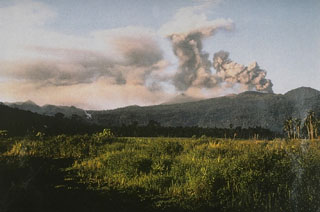Report on Dukono (Indonesia) — June 2003
Bulletin of the Global Volcanism Network, vol. 28, no. 6 (June 2003)
Managing Editor: Edward Venzke.
Dukono (Indonesia) Ash eruptions in February, June, and July 2003
Please cite this report as:
Global Volcanism Program, 2003. Report on Dukono (Indonesia) (Venzke, E., ed.). Bulletin of the Global Volcanism Network, 28:6. Smithsonian Institution. https://doi.org/10.5479/si.GVP.BGVN200306-268010
Dukono
Indonesia
1.6992°N, 127.8783°E; summit elev. 1273 m
All times are local (unless otherwise noted)
According to the Volcanological Survey of Indonesia (VSI), Dukono erupted at 0105 on 22 February 2003. A gray-black ash cloud rose to 500 m and drifted E and then S. During 1200-1355 fiery flashes were observed for ~30 minutes, and on 28 February activity returned to normal.
The Darwin VAAC reported that an ash plume was visible on NOAA and GOES 9 imagery beginning on 8 June at 1625. The ash plume reached ~4.5 km altitude and drifted NE. On 9 June ashfall reached the Galela area, as far as 7 km from the summit. Explosive activity decreased, but a blasting sound was still frequent. The Alert Level was set at 2 (on a scale of 1-4). As of 10 June the plume was visible on satellite imagery extending ~75 km N.
During 3-8 July activity preceded by gas emissions from the crater was observed and a gas plume rose 25-75 m. Ash explosions during 9-14 July produced ash columns 800-900 m high, accompanied by a continuous strong blasting sound. Ash fell around the Mamuya and Galela areas. A white-gray ash plume emitted during the week of 15-23 July rose 375 m. On 22 July, an ash explosion from the crater in clear, calm conditions, formed an ash column that reached a maximum height of 1,000 m.
Geological Summary. The Dukono complex in northern Halmahera is on an edifice with a broad, low profile containing multiple peaks and overlapping craters. Almost continuous explosive eruptions, sometimes accompanied by lava flows, have occurred since 1933. During a major eruption in 1550 CE, a lava flow filled in the strait between Halmahera and the Gunung Mamuya cone, 10 km NE. Malupang Wariang, 1 km SW of the summit crater complex, contains a 700 x 570 m crater that has also had reported eruptions.
Information Contacts: Volcanological Survey of Indonesia (VSI), Jalan Diponegoro No. 57, Bandung 40122, Indonesia (URL: http://www.vsi.esdm.go.id/); Darwin Volcanic Ash Advisory Centre (VAAC), Bureau of Meteorology, Northern Territory Regional Office, PO Box 40050, Casuarina, NT 0811, Australia (URL: http://www.bom.gov.au/info/vaac/).

